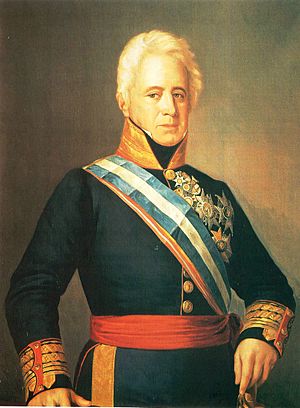Pedro Agustín Girón facts for kids
Quick facts for kids
The Most Excellent
The Duke of Ahumada
|
|
|---|---|

Portrait by Francisco Jover y Casanova
|
|
| Personal details | |
| Born | 2 January 1778 |
| Died | 17 May 1842 (aged 64) |
| Military service | |
| Allegiance | |
| Rank | Lieutenant General |
| Battles/wars | War of the Pyrenees Peninsular War
|
Pedro Agustín Girón y de Las Casas, 1st Duke of Ahumada, 4th Marquess of the Amarillas (1778–1842) was an important Spanish military leader and politician. He was born into a noble family and followed in his father's footsteps, becoming a general. Pedro Agustín Girón is best known for fighting against the French armies during the Napoleonic Wars, especially in the Peninsular War in Spain. Later in his life, he held important government jobs.
Contents
Early Life and Military Beginnings
Pedro Agustín Girón was born in San Sebastián, Spain, in 1778. His father was Jerónimo Girón-Moctezuma, 3rd Marquis de las Amarilas, who was also a high-ranking general. His mother was Isabel de las Casas y Aragorri. Pedro was actually a descendant of the famous Aztec Emperor Moctezuma II!
He joined the Guardia Real, which was like the Royal Guard. He fought in the War of the Pyrenees, a war against France, where his father was also a general.
Fighting Napoleon's Army
When the French Emperor Napoleon I of France invaded Spain and took over the government, Pedro Agustín Girón joined the Spanish forces who wanted to fight back. This war is known as the Peninsular War (or the Spanish War of Independence).
He took part in many important battles:
- In July 1808, he fought in the Battle of Bailén, where the Spanish army defeated the French.
- Later that year, he was at the Battle of Tudela in Navarre.
- In 1809, he fought in the Battle of Uclés.
- In 1811, he was part of the Battle of Albuera.
By 1813, the French were being pushed out of Spain. Pedro Agustín Girón's troops helped in this effort. On October 7, 1813, at the Battle of the Bidassoa, he led two divisions of soldiers from Andalusia. Even though they attacked the French defenses many times, they couldn't capture the position. However, The Marquess of Wellington, a famous British general, praised the Spanish soldiers. He said they attacked "in as good order and with as much spirit as any that I have seen made by any troops." The French left the position the next day.
Pedro Girón also led his troops at the Battle of Nivelle on November 10, 1813. His soldiers helped capture the fortified village of Sare.
Political Roles and Later Life
In 1819, when his father passed away, Pedro became the 4th Marquess of Amarilas. He was known as a "moderate liberal" in politics, meaning he supported some changes but not extreme ones.
After a big political change in 1820, he was made Minister of War in the government. However, he resigned after only a few months because other politicians who wanted more radical changes disagreed with him.
In 1832, he was made Commander-in-Chief of Granada. The next year, he received the special title of Duque de Ahumada (Duke of Ahumada). In 1835, he was again named Minister of War, but he had to resign because some people accused him of nepotism. This means he was accused of giving jobs or favors to family members or friends instead of the most qualified people.
In his final years, he traveled a lot and spent time studying and writing. He wrote his memoirs, called Memories 1778-1837, which tell about his life. He passed away in 1842.
Pedro's son, Francisco Javier Girón y Ezpeleta, 2nd Duke of Ahumada and 5th Marquess of the Amarillas, went on to found the Spanish Guardia Civil in 1844. The Guardia Civil is a very important police force in Spain today.
See also
 In Spanish: Pedro Agustín Girón para niños
In Spanish: Pedro Agustín Girón para niños

